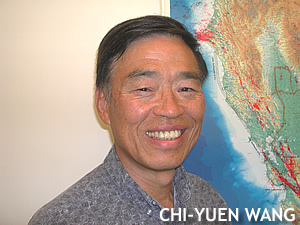

 |
|
Professor Chi Y. Wang received his Bachelor degree in geology from the Taiwan National University in 1958. Following two years of manditory military training in Taiwan, he came to the U.S. in 1960 for graduate education under Francis Birch at Harvard University where he received his Ph.D. degree in 1964. From 1964 to 1967, he worked at the Smithsonian Astrophysical Observatory as a geophysicist to study the earth's gravitational field using the then newly available artificial satellite data. During this time he hypothesized that the earth's 'excess' oblateness (in excess of its hydrostatic shape) was a result of its delayed response to the sudden disappearance of the ice-caps following the last ice age - a hypothesis that has since been largely sustained by later studies. Since 1967 he
has been a faculty member of the department of Earth & Planetary
Science at UC Berkeley. He studied the earth's density using the
then newly available data for the earth's free oscillations and,
at the same time, he set up a high-pressure laboratory in the department
to study the seismic-wave velocity and the mechanical property of
rocks under high pressure. Since the late 1980's, he and his students
have applied information on rock's mechanical property to study
regional-scaled tectonic and transport processes, using numerical
simulation as a tool. |
 |
||||||||||
 |
||||||||||